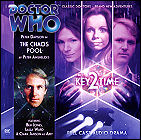 The search for the final segment of the Key to Time leads to the starship Eschaton, which is itself on a search for a destination known only as the Chaos Pool. But pursuing the Eschaton is a shipload of Teuthoidians, carnivorous slug-like creatures who, according to the Doctor, shouldn’t be there: they’re at the wrong end of time, which may mean that the decaying final segment of the Key is causing events near the death of the universe to “wrap around” and meet events at the dawn of time itself. Zara is also here, having ingratiated herself with the crew of the Eschaton, and she uses the power of the segments in her possession to take Amy’s place and throw the Doctor off his search. The Doctor is stunned when he meets a familiar face in command of the Eschaton, but things are not as they seem: the Guardians are no longer trapped in Earth’s distant past, and rather than simply relying on a few hand-picked agents, they have amassed armies, each hoping to claim the Key for himself. But the Guardians didn’t actually create the Key; the beings who created Amy and Zara did. When they appear, all bets are off, and they expect everyone, from Amy and Zara to the Doctor, to do their bidding without question… or die.
The search for the final segment of the Key to Time leads to the starship Eschaton, which is itself on a search for a destination known only as the Chaos Pool. But pursuing the Eschaton is a shipload of Teuthoidians, carnivorous slug-like creatures who, according to the Doctor, shouldn’t be there: they’re at the wrong end of time, which may mean that the decaying final segment of the Key is causing events near the death of the universe to “wrap around” and meet events at the dawn of time itself. Zara is also here, having ingratiated herself with the crew of the Eschaton, and she uses the power of the segments in her possession to take Amy’s place and throw the Doctor off his search. The Doctor is stunned when he meets a familiar face in command of the Eschaton, but things are not as they seem: the Guardians are no longer trapped in Earth’s distant past, and rather than simply relying on a few hand-picked agents, they have amassed armies, each hoping to claim the Key for himself. But the Guardians didn’t actually create the Key; the beings who created Amy and Zara did. When they appear, all bets are off, and they expect everyone, from Amy and Zara to the Doctor, to do their bidding without question… or die.
written by Peter Anghelides
directed by Lisa Bowerman
music by Jamie RobertsonCast: Peter Davison (The Doctor), Ciara Janson (Amy), Laura Doddington (Zara), Lalla Ward (Madam President), David Troughton (The Black Guardian), Ben Jones (Captain Pargrave), Toby Longworth (Commander Hectocot), Cate Hamer (The Voice)
Notes: Chronologically, this story takes place before the Gallifrey audio spin-off series, and as such, Amy’s fate ties in with elements of the Gallifrey storyline, even though she isn’t featured in that series by name.
Timeline: between The Destroyer Of Delights and The Caves Of Androzani
LogBook entry and TheatEar review by Earl Green
Review: The Chaos Pool is a wrap-up to the “Key 2 Time” cycle that only a fan could love. The same could arguably be said about the entire concept of sequelizing the original Key to Time storyline, but The Chaos Pool brings things home with continuity references to characters and events that, quite frankly, I never expected to appear again.
The good news is that, if you are a longtime fan who “gets” these things, this results in a couple of really nifty cliffhangers. This story cycle began with the revelation that the fourth Doctor may have messed up in a big way by temporarily assembling the Key with one counterfeit segment; it turns out that other consequences were unexpectedly set into motion, including a few things that explain a long-standing minor mystery of Doctor Who continuity (I won’t spoil which one in this review). If I had to compare The Chaos Pool to a televised Doctor Who adventure, it would be similar to Warriors’ Gate or Terminus – there’s a lot going on with high-concept story elements, and there’s a lot going on with characters and plot (including resolving a story arc), and these things jostle with each other for center stage.
It’s interesting to hear Lalla Ward alongside Peter Davison, though perhaps not surprisingly, she sometimes overpowers the occasionally-too-polite fifth Doctor with her acid wit. But make no mistake, this story really belongs to Ciara Janson and Laura Doddington as, respectively, Amy and Zara; once the Guardians reappear, they steal the show as well, with one particularly interesting scene over a game of bridge (!).
One other minor quibble is the uncharacteristically grand music that fills both The Chaos Pool and The Judgement Of Isskar. I’m torn on the issue of whether or not Big Finish should try to hew toward the musical style of the BBC Radiophonic Workshop; I can see where that’d get old very quickly. But the opening and closing stories of this cycle used some very well-worn pre-recorded orchestral samples (I could swear I’ve heard the same samples/sequences on Babylon 5) that, in a few places, seemed so strangely “un-Doctor Who” that they almost took me out of the story. It’s not that they didn’t fit the mood, but they were noticeably outside of the usual house style.
Overall, the Key 2 Time cycle is an interesting experiment. The concept of grouping stories featuring a particular combination of Doctor and companion(s) into “mini-seasons” is neat – it allows for some further experiments with a story arc structure, and less of a frustrating wait between conncected stories.
